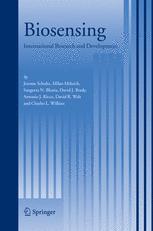

Most ebook files are in PDF format, so you can easily read them using various software such as Foxit Reader or directly on the Google Chrome browser.
Some ebook files are released by publishers in other formats such as .awz, .mobi, .epub, .fb2, etc. You may need to install specific software to read these formats on mobile/PC, such as Calibre.
Please read the tutorial at this link: https://ebookbell.com/faq
We offer FREE conversion to the popular formats you request; however, this may take some time. Therefore, right after payment, please email us, and we will try to provide the service as quickly as possible.
For some exceptional file formats or broken links (if any), please refrain from opening any disputes. Instead, email us first, and we will try to assist within a maximum of 6 hours.
EbookBell Team

4.4
62 reviewsThe goal of this book is to disseminate information on the worldwide status and trends in biosensing R&D to government decisionmakers and the research community. The contributors critically analyze and compare biosensing research in the United States with that being pursued in Japan, Europe and other major industrialized countries.
Biosensing includes systems that incorporate a variety of means, including electrical, electronic, and photonic devices; biological materials (e.g., tissue, enzymes, nucleic acids, etc.); and chemical analysis to produce detectable signals for the monitoring or identification of biological phenomena. In a broader sense, the study of biosensing includes any approach to detection of biological elements and the associated software or computer identification technologies (e.g., imaging) that identify biological characteristics. Biosensing is finding a growing number of applications in a wide variety of areas, including biomedicine, food production and processing, and detection of bacteria, viruses, and biological toxins for biowarfare defense. Subtopics likely to be covered in this study include the following: Nucleic acid sensors and DNA chips and arrays, organism- and cell-based biosensors, bioelectronics and biometrics, biointerfaces and biomaterials; biocompatibility and biofouling, integrated, multi-modality sensors and sensor networks, system issues, including signal transduction, data interpretation, and validation, novel sensing algorithms, e.g., non-enzyme-based sensors for glucose, mechanical sensors for prosthetics, related issues in bio-MEMS and NEMS (microelectromechanical and nanoelectromechanical systems), possibly including actuators, applications in biomedicine, the environment, food industry, security and defense.
Particular emphasis will be on technologies that may lead to portable or fieldable devices/instruments. Important consideration will be given to an integrated approach to detection, storage, analysis, validation, interpretation and presentation of results from the biosensing system. Focus will be on research from the following disciplines:
BioMems & nano, optical spectroscopy, mass spectroscopy, chemometrics, pattern recognition, telemetry, signal processing, and toxicology.
Finally, beyond the above technical issues, the study will also address the following non-technical issues: Mechanisms for enhancing international and interdisciplinary cooperation in the field, opportunities for shortening the lead time for deployment of new biosensing technologies emerging from the laboratory, long range research, educational, and infrastructure issues that need addressed to promote better progress in the field, current government R&D funding levels overseas compared to the United States, to the extent data are available.